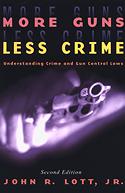 Armed America: The Remarkable Story of How and Why Guns Became as American as Apple Pie, By Clayton Cramer, Nelson, 320 pages, $26.99
Armed America: The Remarkable Story of How and Why Guns Became as American as Apple Pie, By Clayton Cramer, Nelson, 320 pages, $26.99
Did you know that in New York City, through 1969 virtually all the public high schools had riflery teams?
Thousands of students carried their rifles on subways, buses and streets on their way to school, when they went to practice in the afternoon and on their way home. And until 1963, all commercial pilots were required to carry guns and were allowed to carry guns until 1987.
Gun laws have certainly changed over time.
Today towns such as Kennesaw, Ga., Greenfeld, Idaho and Geuda Springs, Kan., which all require residents to own guns, are considered the oddity. But Clayton Cramer’s terrific new book, “Armed America,” shows that, in fact, gun ownership has been deeply woven into this country’s history since the colonial period.
Cramer shows that guns aren’t inherently the problem. In our day, criminals may have replaced Indians as a danger facing most citizens, but it may also shock many readers to learn how comfortable Americans once were with their guns.
In colonial times, as Cramer argues, people didn’t own guns just for hunting. Numerous laws mandated that people have guns for personal defense and defense of the community, at home, while traveling and even in church.
Heads of households, whether men or women, were required to have a gun at home and fines of up to a month’s wages were imposed on those who failed to meet this requirement.
In some states such as Maryland, fines were paid directly to inspectors so that authorities had a strong incentive to check. The only people exempt from these rules were Quakers, some indentured servants, or, in the South, blacks.
 Fear of attack by Indians and England’s European enemies meant that people were required to own and carry guns when traveling, though sometimes older people were exempted.
Fear of attack by Indians and England’s European enemies meant that people were required to own and carry guns when traveling, though sometimes older people were exempted.
 At least six colonies required people have guns with them at church. Church officials were required to check parishioners when they arrived for services to ensure they had a gun. Clergymen were required to have guns, too. Contrast that with the political firestorms that erupt these days when states merely let churches decide whether concealed handgun permit holders can carry guns on church property.
At least six colonies required people have guns with them at church. Church officials were required to check parishioners when they arrived for services to ensure they had a gun. Clergymen were required to have guns, too. Contrast that with the political firestorms that erupt these days when states merely let churches decide whether concealed handgun permit holders can carry guns on church property.
In our day, only about 45 percent of households own a gun, whereas gun ownership in colonial America was much higher, as measured by probate records. Guns were bequeathed to the next generation in about 70 percent of cases.
 The fascinating firsthand historical accounts that Cramer provides indicate that guns were cheap, readily available and essentially everywhere. Given America’s historical amnesia, Cramer’s book helps to remind us about that part of our history many now find improbable.
The fascinating firsthand historical accounts that Cramer provides indicate that guns were cheap, readily available and essentially everywhere. Given America’s historical amnesia, Cramer’s book helps to remind us about that part of our history many now find improbable.
This article was originally published Sunday, March 11, 2007, in the New York Post.




